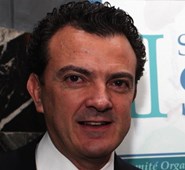Meeting
2020 ASCO Virtual Scientific Program

Hospital Universitario 12 de Octubre, Madrid, Spain
Daniel Castellano , Craig Gedye , Giuseppe Fornarini , Andre P. Fay , Jens Voortman , Michal Mego , Aristotelis Bamias , Jason Francis Lester , Robert A Huddart , Michaela Matouskova , Howard Gurney , Begona Mellado , Michael Ong , Filipa Carneiro , Florian Seseke , Laura Milesi , Shahrokh F. Shariat , Simon Fear , Sabine de Ducla , Cora N. Sternberg
Background: Pts with PS > 1 have a poor prognosis and are often excluded from clinical trials. The single-arm SAUL study (NCT02928406) evaluated atezo in a ‘real-world’ population. Overall, safety and efficacy were consistent with prior trials. However, ECOG PS 2 pts had worse overall survival (OS) but fewer adverse events (AEs) than ECOG PS 0/1 pts [Sternberg, 2019], likely reflecting shorter treatment duration and warranting exploration. Methods: Pts with mUTC received atezo 1200 mg q3w until loss of clinical benefit or unacceptable toxicity. The primary endpoint was safety. Post hoc analyses compared baseline factors, AEs and efficacy in pts with ECOG PS 2 vs 0/1. In this analysis, AE incidences were restricted to the first 45 days of atezo to adjust for differing treatment exposure. Results: None of the baseline factors explored was significantly associated with worse OS or disease control rate (DCR) in ECOG PS 2 pts. However, pts with visceral metastases and ECOG PS 2 had particularly poor outcomes. Safety appeared similar between subgroups. Conclusions: ECOG PS 2 pts have a dismal prognosis. The higher proportion with poor prognostic factors despite similar age in ECOG PS 2 vs 0/1 pts may suggest that poor PS was related to disease rather than comorbidities. Risk/benefit should be considered especially carefully when treating pts with ECOG PS 2 due to high-burden/visceral disease. Clinical trial information: NCT02928406.
| Parameter, n (%) | ECOG PS | |
|---|---|---|
| 2 (n = 101) | 0/1 (n = 896) | |
| Median age, y (range) | 69 (43–93) | 68 (34–92) |
| Age ≥80 y | 10 (10) | 68 (8) |
| Male | 78 (77) | 694 (77) |
| Renal impairment | 2 (2) | 44 (5) |
| Visceral metastases | 52 (52) | 322 (36) |
| Low Hb | 32 (32) | 118 (13) |
| Low albumin | 46 (47)a | 183 (21)b |
| Low ALP | 45 (45)c | 207 (23)d |
| PD-L1 IC 2/3 | 21 (21)e | 243 (27)f |
| No prior chemo for mUTC | 27 (27) | 355 (40) |
| AE, days 1–45 | ||
| Any G | 75 (74) | 656 (73) |
| G3/4 | 43 (43) | 216 (24) |
| G5 | 5 (5) | 10 (1) |
| Treatment related | 30 (30) | 339 (38) |
| Special interest | 13 (13) | 143 (16) |
| AE leading to atezo withdrawal | 2 (2) | 25 (3) |
| Median OS, mo (95% CI) | 2.3 (1.6–2.6) | 10.0 (8.9–11.2) |
| Objective response rate [95% CI] | 5 (5) [2–11] | 130 (15) [12–17] |
| DCRg [95% CI] | 14 (14) [8–22] | 384 (43) [40–46] |
an = 97; bn = 873; cn = 100; dn = 889; en = 91; fn = 837. gCR/PR or stable disease for ≥4 wks
G = grade
Disclaimer
This material on this page is ©2024 American Society of Clinical Oncology, all rights reserved. Licensing available upon request. For more information, please contact licensing@asco.org
2020 ASCO Virtual Scientific Program
Poster Session
Genitourinary Cancer—Kidney and Bladder
Genitourinary Cancer—Kidney and Bladder
Bladder Cancer
NCT02928406
J Clin Oncol 38: 2020 (suppl; abstr 5035)
10.1200/JCO.2020.38.15_suppl.5035
5035
104
Abstract Disclosures
2023 ASCO Annual Meeting
First Author: Cora N. Sternberg
2023 ASCO Annual Meeting
First Author: Chunjiao Wu
2023 ASCO Annual Meeting
First Author: Richard S. Finn
2022 ASCO Annual Meeting
First Author: Jin Gang